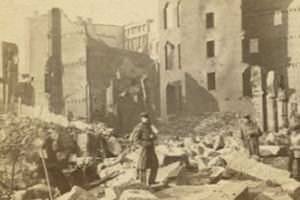 |
Great Boston Fire, 1872
The following is an account of the Great Boston Fire of 1872. Boston had several "Great" fires, but the 1872 conflagration caused the greatest destruction. Much of the downtown area was completely destroyed. The fire started at Summer and Kingston Streets.
"The Great Boston Fire began on the night of Saturday November 9, 1872, in the finest business quarter of the city. It was not brought under control until late afternoon the following day, and was by far the most disastrous of several great fires that Boston has suffered.
The fire destroyed more than 65 acres of the most valuable business property of the city, in a district bounded by Summer, Washington, Milk, and Broad Streets. The number of firms burned out was about 960. Near Summer and Kingston Streets, where the fire originated, 112 firms were burned out. On Pearl Street, 185 firms were burned out. Also destroyed were long blocks of warehouses filled with wool, leather, boots and shoes, paper, and hardware. Nearly 300 establishments in the wholesale dry goods trade alone, were swept away.

The total number of buildings that fell victim to the flames was 776, of which 709 were of brick, granite, or stone, and 67 of wood. The value of all property destroyed was $75,000,000 [about $3.5 billion current dollars].
The [old] post office building at Post Office Square escaped destruction, but was somewhat damaged. The spread of fire into State and other streets was only checked by blowing up buildings. The fire raged hottest in Milk, Congress, and Federal Streets, Winthrop Square, Devonshire, and Franklin Streets.
During the height of the fire, the city was thrown into a panic, but disorder was quickly checked. Portions of the militia were called out and aided the police patrols, which prevented wholesale lawlessness and robbery by those who are always quick to gather on such occasions for plunder.
The Boston Fire Department was reinforced from suburban towns and distant cities. When the initial shock was over, the fire was fought systematically and well. It was difficult for the fire engines to get to the scene promptly on account of the horse distemper then raging, which had for sometime rendered many horses useless. Due to this fact, the fire had rapidly spread before many of the fire engines were available for work.
Great and appalling was this disaster, but the city recovered from it bravely. Losses were adjusted as speedily as possible; new quarters were quickly obtained by burnt out firms; and, before the smoke from the ruins had faded away, rebuilding had begun. Within a year, the burnt district was largely rebuilt with substantial structures; and again was the finest and most impressive section of the business quarters of the city, with better buildings than before, more fire resistant, and architecturally attractive [most are demolished today].
Some of the good results of the fire were improved and stricter building codes, a more organized and complete fire department, and safer buildings.
Historical Location:
Origin of Great Boston Fire
Summer &
Kingston Streets, Boston, MA 02110